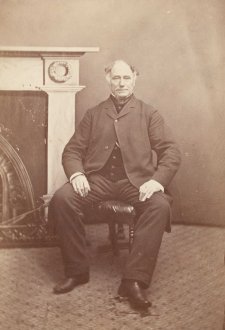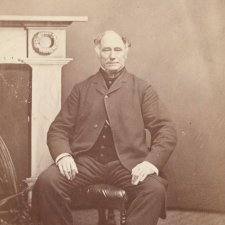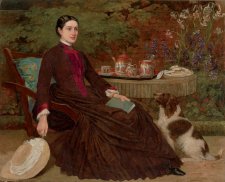- About us
- Support the Gallery
- Venue hire
- Publications
- Research library
- Organisation chart
- Employment
- Contact us
- Make a booking
- Onsite programs
- Online programs
- School visit information
- Learning resources
- Little Darlings
- Professional learning
William Robertson (1839–1892), lawyer, politician and pastoralist, was the second eldest son and third child of merchant and landowner William Robertson and his wife Margaret. William senior had emigrated to Van Diemen’s Land in the 1820s, building a successful business in Hobart before relocating to Victoria. William junior was educated in Hobart and then at Wadham College, Oxford. While there ‘he entered with zest into the athletics of the place, and he rowed in the Oxford and Cambridge annual boat race on the Thames in 1861.’ He graduated in 1862 and the following year, in Tunbridge Wells, he married Martha Mary Murphy (1844–1909). On returning home William and Martha settled initially in Hobart before William was admitted to the bar in Victoria. He and his brothers John, George and James each inherited property on their father’s death in 1874, William acquiring The Hill, ‘a stretch of very rich agricultural and grazing land’ near Colac. As Robertson Brothers the four managed the family’s various pastoral concerns, developing a reputation for their shorthorn cattle. William was a member of the Victorian Legislative Assembly in the 1870s and 1880s, ‘but his interest in politics was not very keen’. ‘He was much better fitted to shine in social life’, his obituary said, ‘being a man of amiable disposition and high private character.’ He died while undergoing surgery for cancer in 1892.
William Edward Kilburn (1818–1891) was one of London’s earliest exponents of the daguerreotype. He opened his first studio on Regent Street, London, in 1847 and in 1848 Prince Albert acquired Kilburn’s daguerreotypes showing a large Chartist gathering at Kennington. This led to Kilburn being appointed ‘Her Majesty's Daguerreotypist’ and began an association with the Royal Family that resulted in a number of portraits over the next several years. Leading members of society admired Kilburn’s work, which was often finely hand-coloured or engraved for publication in illustrated newspapers. Kilburn adapted easily to the waning popularity of the daguerreotype and the advent of paper photographs, his studio becoming a leading London supplier of cartes de visite in the late 1850s, and sitters such as Florence Nightingale and Benjamin Disraeli had cartes de visite taken by him. He is perhaps of especial interest to historians of Australian photography as the brother of Douglas Kilburn, who is considered Melbourne’s first professional photographer. Douglas’s early advertisements state that ‘Mr Kilburn, having just received materials and the latest information from his brother, in London (Photographic Artist to the Queen), will be ready next week to TAKE LIKENESSES by the Daguerreotype Process.’
Collection: National Portrait Gallery
Gift of Malcolm Robertson in memory of William Thomas Robertson 2018. Donated through the Australian Government's Cultural Gifts Program.
William Edward Kilburn (age 45 in 1863)
William Robertson Jnr (age 24 in 1863)
Martha M. Robertson (age 19 in 1863)
Malcolm Robertson (16 portraits)



On one level The Companion talks about the most famous and frontline Australians, but on another it tells us about ourselves.



20 July 2023
To celebrate his family bicentenary, Malcolm Robertson looks at the portraiture legacy left by his ancestors.



Malcolm Robertson tells the family history of one of Australia's earliest patrons of the arts, his Scottish born great great great grandfather, William Robertson.